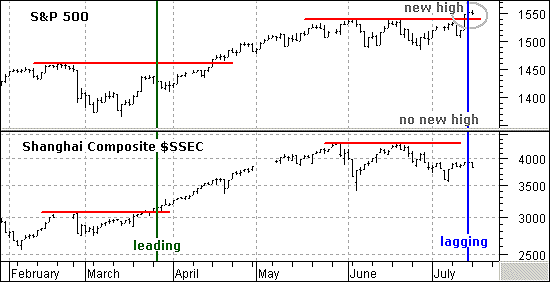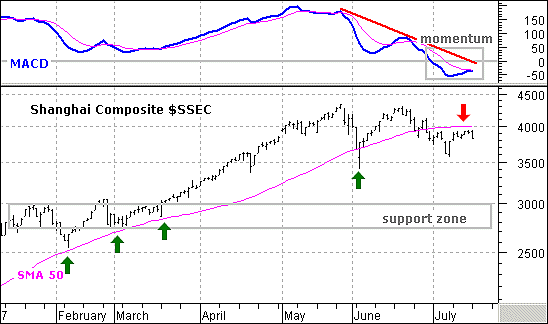
HOT TOPICS LIST
- MACD
- Fibonacci
- RSI
- Gann
- ADXR
- Stochastics
- Volume
- Triangles
- Futures
- Cycles
- Volatility
- ZIGZAG
- MESA
- Retracement
- Aroon
INDICATORS LIST
LIST OF TOPICS
PRINT THIS ARTICLE
by Arthur Hill
The Shanghai Composite led the world from March to May, but this key index is lagging in July and a failure at the 50-day looks ominous.
Position: Sell
Arthur Hill
Arthur Hill is currently editor of TDTrader.com, a website specializing in trading strategies, sector/industry specific breadth stats and overall technical analysis. He passed the Society of Technical Analysts (STA London) diploma exam with distinction is a Certified Financial Technician (CFTe). Prior to TD Trader, he was the Chief Technical Analyst for Stockcharts.com and the main contributor to the ChartSchool.
PRINT THIS ARTICLE
MOVING AVERAGES
Shanghai Composite Starts To Lag
07/23/07 09:06:38 AMby Arthur Hill
The Shanghai Composite led the world from March to May, but this key index is lagging in July and a failure at the 50-day looks ominous.
Position: Sell
| While the Standard & Poor's 500 broke above its June highs with a surge over the past week, the Shanghai Composite ($SSEC) remained well below its June highs, showing relative weakness. The Shanghai Composite was actually leading the S&P 500 in March when it broke above its February highs well before the S&P 500 did. Now, the index cannot keep up, and relative weakness is often the first sign of trouble. See Figure 1. |

|
| FIGURE 1: S&P 500 VS. $SSEC. The Shanghai Composite was actually leading the S&P 500 in March when it broke above its February highs well before the S&P 500 did. |
| Graphic provided by: MetaStock. |
| |
| Support turns into resistance. This key tenet of technical analysis can apply to the price support from a reaction low or indicator support from a moving average. In this case, the 50-day moving average provided support during the advance with successful tests in February, March, and June. The index actually broke below the 50-day moving average on June 5 (intraday), but recovered by the end of the day and closed above the 50-day MA. Because the moving average is based on closing prices, we should also base signals on closing prices. |

|
| FIGURE 2: MACD VS. $SSEC. The MACD peaked in May and moved lower in June. |
| Graphic provided by: MetaStock. |
| |
| The index broke below the 50-day moving average in late June and closed below this key indicator during the last 13 days. The average now offers resistance around 4000, and it would take a close above this level to revive the bulls. As long as the break holds, I view it as bearish and expect a move lower. The next support zone is around 2800–3000, and this is the target. |
| Momentum confirms weakness. The moving average convergence/divergence (MACD) peaked in May and moved lower in June (Figure 2). The indicator formed a lower high in late June and moved into negative territory for the first time since August. The move into negative territory is bearish for momentum and the bears have the edge. Look for a break back above zero to revive momentum and call for a reassessment of my bearish stance. |
Arthur Hill is currently editor of TDTrader.com, a website specializing in trading strategies, sector/industry specific breadth stats and overall technical analysis. He passed the Society of Technical Analysts (STA London) diploma exam with distinction is a Certified Financial Technician (CFTe). Prior to TD Trader, he was the Chief Technical Analyst for Stockcharts.com and the main contributor to the ChartSchool.
| Title: | Editor |
| Company: | TDTrader.com |
| Address: | Willem Geetsstraat 17 |
| Mechelen, B2800 | |
| Phone # for sales: | 3215345465 |
| Website: | www.tdtrader.com |
| E-mail address: | arthurh@tdtrader.com |
Traders' Resource Links | |
| TDTrader.com has not added any product or service information to TRADERS' RESOURCE. | |
Click here for more information about our publications!
PRINT THIS ARTICLE

|

Request Information From Our Sponsors
- StockCharts.com, Inc.
- Candle Patterns
- Candlestick Charting Explained
- Intermarket Technical Analysis
- John Murphy on Chart Analysis
- John Murphy's Chart Pattern Recognition
- John Murphy's Market Message
- MurphyExplainsMarketAnalysis-Intermarket Analysis
- MurphyExplainsMarketAnalysis-Visual Analysis
- StockCharts.com
- Technical Analysis of the Financial Markets
- The Visual Investor
- VectorVest, Inc.
- Executive Premier Workshop
- One-Day Options Course
- OptionsPro
- Retirement Income Workshop
- Sure-Fire Trading Systems (VectorVest, Inc.)
- Trading as a Business Workshop
- VectorVest 7 EOD
- VectorVest 7 RealTime/IntraDay
- VectorVest AutoTester
- VectorVest Educational Services
- VectorVest OnLine
- VectorVest Options Analyzer
- VectorVest ProGraphics v6.0
- VectorVest ProTrader 7
- VectorVest RealTime Derby Tool
- VectorVest Simulator
- VectorVest Variator
- VectorVest Watchdog
